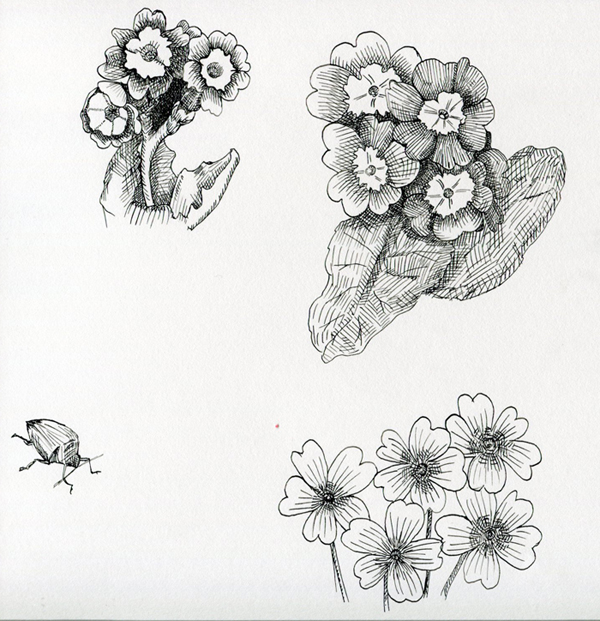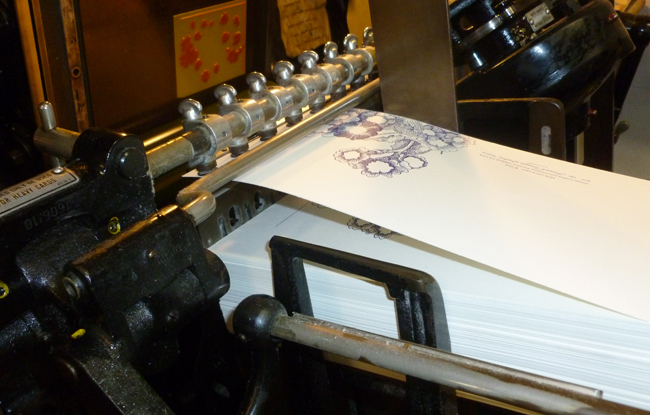We thought you might like to see our unusual methods for growing flowers at Painted Tongue Press, so we’ve put together a photo essay about it.
We begin by studying photographs of the flower, plant or vegetable that will be the subject of our next card – in this case, primrose. When our card line started out, we used old botanical engravings and illustrations, but all of the recent cards in our line are drawn from scratch, in house, by Kim Vanderheiden.
 Kim uses the photographs from various sources as a basis for understanding the plant’s nature and behavior, and variations on how it grows. She uses sections of photographs as a basis for the illustrations, but changes elements to suit the needs of the drawing. It’s important to capture the botanical nature of the plant and not copy a photographer’s composition. She draws the plant in vignettes because that plays into the way we create our final composition on the card. Here are the primrose drawings that were used for our card, complete with the little critter.
Kim uses the photographs from various sources as a basis for understanding the plant’s nature and behavior, and variations on how it grows. She uses sections of photographs as a basis for the illustrations, but changes elements to suit the needs of the drawing. It’s important to capture the botanical nature of the plant and not copy a photographer’s composition. She draws the plant in vignettes because that plays into the way we create our final composition on the card. Here are the primrose drawings that were used for our card, complete with the little critter.
Each card has a critter. Sometimes it’s a small bug. Sometimes it’s something more obvious like a bird or rabbit.
After the drawing is complete, we scan it at high resolution, and add the color in Photoshop. Primrose here gave us a lot of trouble on color.
You see, with letterpress, it’s costly to print each color. If we made our cards with more than two colors, we’d have to charge so much you wouldn’t be likely to buy them. Sometimes, though, we overlap two colors to make a third without the extra press run. In this case, the original intent was to overlap the yellow and blue to make green leaves. Unfortunately it isn’t as straightforward as it seems. The yellow ink is translucent and many of the blue inks have a good deal of red tone in them. They are also much more dominant than the yellow. We considered a lighter blue ink with a lot of transparent base to let the yellow come through, but the blue looked weak and the green was too brown. In the end, after much fiddling with the color and debate, we decided to go with blue leaves, and not do the overlap, allowing us to select a richer blue for the flowers. This card design was created by Mitsuko Baum. Kim and Mitsuko work on the card designs together.
After completing the design, we separate the digital file so that all the yellow parts will go onto one plate and all the blue parts onto another. This picture shows the yellow plate in the press.
The separated file is black and white, and is then printed out as a film negative. The black areas become clear, the white becomes black. We place the negative over a UV light sensitive plate material to expose the clear areas of the negative. When we wash the plate afterwards, the exposed areas remain and the rest of the plate’s surface washes away, leaving behind a thin metal substrate. The plate can then be mounted onto a magnetic base and used in any of the antique letterpresses. (They don’t make ’em new anymore!) You can see the plate sticking to the magnetic base in this picture.
 Once the plates are made, we print them one at at time. Here the blue is printed first, because we can make sure the text is straight on the back of the card, and it’s the best plate to print first if you want to make sure the card is lined up correctly for easier trimming and scoring later.
Once the plates are made, we print them one at at time. Here the blue is printed first, because we can make sure the text is straight on the back of the card, and it’s the best plate to print first if you want to make sure the card is lined up correctly for easier trimming and scoring later.
The paper in this picture is in the feed tray of the press, ready to receive it’s second color. This is the blank note version of the card. There is another stack identical to this one with the “Thank You” already printed at the top that is also waiting for the yellow.
 Here’s one of those blue cards, being sucked into place as it’s gripped by the feed arm of the press. The two feed arms rotate through the press cycle, picking up, pressing, and dropping off sheets of paper, giving the press it’s name, the Heidelberg Windmill.
Here’s one of those blue cards, being sucked into place as it’s gripped by the feed arm of the press. The two feed arms rotate through the press cycle, picking up, pressing, and dropping off sheets of paper, giving the press it’s name, the Heidelberg Windmill.
 Here’s the feed arm positioning the card into the press bed, against the guides on the bottom and with the tympan behind it for support.
Here’s the feed arm positioning the card into the press bed, against the guides on the bottom and with the tympan behind it for support.
 And the press is closing… closing… and… Hey Presto! It exerts up to 60 tons of pressure, imprinting the inked plate firmly into the paper. The press can be run slowly or quickly, but either way, the printing of one sheet happens in a blink of an eye, or faster.
And the press is closing… closing… and… Hey Presto! It exerts up to 60 tons of pressure, imprinting the inked plate firmly into the paper. The press can be run slowly or quickly, but either way, the printing of one sheet happens in a blink of an eye, or faster.
 Then the feed arm drops the paper off in the tray and swings around again to pick up the next blue card and add the yellow to it.
Then the feed arm drops the paper off in the tray and swings around again to pick up the next blue card and add the yellow to it.
Voila! Two neat stacks of our Primrose cards: one stack blank note cards, and the other stack thank you notes. Last they are trimmed and scored, and then placed in inventory, ready for orders. Would you like one?




